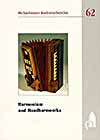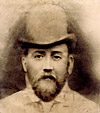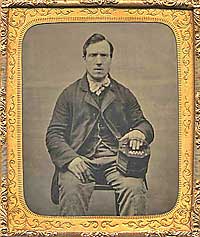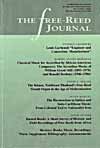Free Reeds Ancient and Modern
Stephen Chambers
Contributions to the Concertina Library by Stephen Chambers.
-
 An Annotated Catalogue of Historic European Free-Reed Instruments from my Private Collection
An Annotated Catalogue of Historic European Free-Reed Instruments from my Private Collection
-
by Stephen Chambers
-
A very important paper describing nineteen instruments which illustrate key points in the development of
European free-reed instruments, with large color photographs.
This paper was presented at the 20th Musikinstrumentenbau-Symposium at Stiftung Kloster Michaelstein, held
19–21 November 1999, to coincide with an exhibition of the instruments.
As Published in Harmonium und Handharmonika (Michaelsteiner Konferenzberichte 62), edited by Monika Lustig,
Michaelstein, 2002, pp. 181-194.
-
Posted 15 January 2004
-
» read full article
-
 Charles Jeffries: the Man and His Family
Charles Jeffries: the Man and His Family
-
by Chris Algar, Stephen Chambers, Robert Gaskins, David Lee, Randall C. Merris, and Wes Williams
-
New information about Charles Jeffries and all of his family that participated
in the concertina making business. Contains the first known pictures of Charles
and Mary Ann Jeffries, and reproductions of birth, marriage, and death certificates
where known. Summary table of Jeffries descendants. Brief descriptions of the
addresses where Charles Jeffries lived and worked, with maps of the Praed Street area,
White Lion Passage, and the Kilburn area. Based on information from members of
the Jeffries family.
-
Posted 15 November 2005
-
» read full article
-
 Earliest Known German Concertina Tutor: Höselbarth’s “Anweisung das Accordion zu spielen”
Earliest Known German Concertina Tutor: Höselbarth’s “Anweisung das Accordion zu spielen”
-
by Stephen Chambers and Dan Worrall
-
Johann Gottlieb Höselbarth published the earliest-known tutor for the German concertina in Chemnitz Germany, in the late 1830s
or early 1840s.
All of the music in this tutor is in the key of C, and several of the tunes in the Appendix
include modulation between the keys of C and G. Chords are typically rich, with up to four notes played at once on the left hand.
All of the tunes are in the so-called harmonic style, where the melody is played on the
right hand, and the chorded accompaniment is played (mostly) on the left. This and an
early tutor of 1846 published in London by Carlos Minasi (see elsewhere on this site)
indicate that the harmonic style of playing dates back to the earliest days of the German
concertina.
-
Posted 15 August 2005
- » read full article
-
 Instructions for the Salvation Army Concertina (1888)
Instructions for the Salvation Army Concertina (1888)
-
by Herbert H. Booth
-
The earliest known concertina tutor for the Salvation Army, compiled by Herbert H. Booth,
son of Salvation Army founder William Booth. This booklet is devoted exclusively to chording
on the Anglo concertina. The title’s phrase “Salvation Army concertina” refers to
an Ab/Eb concertina with 26 keys, the Salvation Army’s standard issue into the
twentieth century. The tutor provides I-IV-V chords (the “three chord trick”) for a number
of keys; the chords are shown as played with two hands without the melody,
presumably as an accompaniment for singing or for other instruments playing melody.
(Scan from Stephen Chambers, description by Randall C. Merris.)
London: Published by The Salvation Army Bookstores, 8 and 9, Paternoster Square, E.C., 1888.
Price 3d. 16pp. including covers.
-
Posted 15 April 2007
-
» read full document in pdf (or right-click to download)
-
 The Concertina Man
The Concertina Man
-
Presented by Peter Day,
Produced by Neil Koenig
-
BBC programme on the history and music of the concertina,
focusing on its inventor Sir Charles Wheatstone as a somewhat belated
recognition of his bicentenary in 2002. In addition to the presenter, Peter Day,
the program features (in order of appearance)
Bob Gaskins, Brian Bowers, Margaret Birley, Stephen Chambers,
Frank James, Douglas Rogers, Sean Minnie, and Steve Dickinson. The program
was produced by Neil Koenig.
BBC World Service programme broadcast 07 September 2004.
-
Posted 22 November 2004
-
» read full article
Do you know another resource that we should include?
Tell us about it.
Reprinted from the Concertina Library
http://www.concertina.com
© Copyright 2000–2025 by Stephen Chambers
|

Unidentified concertinist
with German 2-row “octagon
concertina” c. 1860
|








